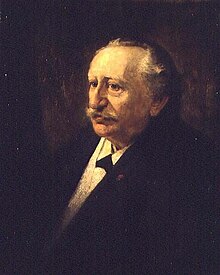Willem Maris

Willem Maris (born February 18, 1844 in The Hague ; † October 10, 1910 there ), also known as Wenzel Maris in German-speaking countries , was a Dutch painter and the youngest son of the Maris family of painters . He is assigned to the Hague School . His typical works are Dutch landscapes with cattle, ducks and other animals, in much lighter colors than the paintings by his brothers Jacob Maris and Matthijs Maris .
Family and life
The three brothers also had an older sister, Henriette. Grandfather Wenzel Maresch came from Prague, married Metge Smit from Amsterdam at the beginning of the 19th century and settled with her in The Hague. In 1809 his son Mattheus was born and registered under the family name Marris . The family later called themselves Maris . Mattheus married Hendrika Bloemert, and since he was a master printer, the children came into contact with art prints by the old masters at an early age, which they admired and tried to imitate. So her talent was discovered early.
Willem received his first drawing lessons from his brothers. He then attended evening classes at the Koninklijke Academie van Beeldende Kunsten (Royal Academy of Fine Arts) in The Hague and was at times apprenticed to the cattle painter Pieter Stortenbeker. Otherwise he was largely self-taught . In The Hague Mauritshaus he copied the work of the animal painter Paulus Potter from the 17th century. He also painted in the artist colony Landgut Oosterbeek and Wolfheze and developed into a landscape and animal painter. In 1855 he met Anton Mauve . His first exhibition took place in The Hague in 1863. In 1865 he traveled with Bernard Blommers through the Rhine states and later to Norway .
From 1869 he stayed in The Hague, where he died at the age of 65. He was buried in the Oud Eik en Duinen cemetery. His son Simon Maris also painted and wrote a book about his family of painters.
In 1903 Floris Arntzenius made a portrait of him.
plant
With its repetitive Dutch landscapes with and without animals and its simple conception of landscape, Maris' work is reminiscent of that of the French Camille Corot .
In 1862 Willem Maris settled in The Hague as a freelance painter and in the same year met Anton Mauve, with whom he had an intensive working friendship throughout his life. They met at the Oosterbeek estate and both painted mostly outdoors.
Like his brothers and Mauve, Willem Maris is also assigned to the Hague School, as his main concern was to capture the mood and atmosphere of a landscape. In the course of time his brushstroke became more and more free and determined. In contrast to the works of his brothers, his landscapes seem flooded with sunlight. Although, as the youngest of the Maris brothers , he should have been the furthest removed from both realism and impressionism , he was arguably the most realistic painter of the three. From another point of view one could come to the conviction that he was the most impressionist, after all he became known for his saying: " Ik schilder geen koeien, maar licht " (German: "I don't paint cows, but light.")
Fredericus van Rossum du Chattel and George Hendrik Breitner were two of his students.
Exhibitions
- 2012: Willem Maris, Impressionist van de Haagse School , January 21 to April 9, 2012, Gemeentemuseum Den Haag
Public collections (selection)
- Boijmans Van Beuningen Museum , Rotterdam
- Museum of Fine Arts , Boston
- National Gallery , London
- Rijksmuseum Amsterdam , Amsterdam
- Ashmolean Museum of the University of Oxford
- Dordrechts Museum , Dordrecht
- Rijksmuseum Twenthe , Enschede
literature
- Max Eisler: Maris, Willem . In: Hans Vollmer (Hrsg.): General lexicon of fine artists from antiquity to the present . Founded by Ulrich Thieme and Felix Becker . tape 24 : Mandere – Möhl . EA Seemann, Leipzig 1930, p. 115 .
- Joost Bergman, Nico de Reus (eds.): Willem Maris. Impressionist van de Haagse School. Wbooks, Zwolle 2012, ISBN 978-90-400-7837-8 . (Exhibition catalog).
Web links
- Rijsbureau voor kunsthistorische documentatie (Dutch, English), with numerous references
- Artcyclopedia (English), with many other references
Individual evidence
- ↑ Caroline Bunnig (Ed.): Een eeuw apart. Het Rijksmuseum en de Nederlandse schilderkunst en de 19de eeuw. Amsterdam 1993, p. 125.
- ↑ Exhibition information . Retrieved December 29, 2014.
- ↑ Exhibition review : Teo van den Brink: Willem Maris describes geen koeien maar light effects. In: Reformatorisch Dagblad of February 1, 2012. Retrieved on December 29, 2014 (Dutch).
- ^ Works in the Museum Boijmans Van Beuningen
| personal data | |
|---|---|
| SURNAME | Maris, Willem |
| ALTERNATIVE NAMES | Maris, Wenceslaus |
| BRIEF DESCRIPTION | Dutch painter |
| DATE OF BIRTH | February 18, 1844 |
| PLACE OF BIRTH | The hague |
| DATE OF DEATH | October 10, 1910 |
| Place of death | The hague |

